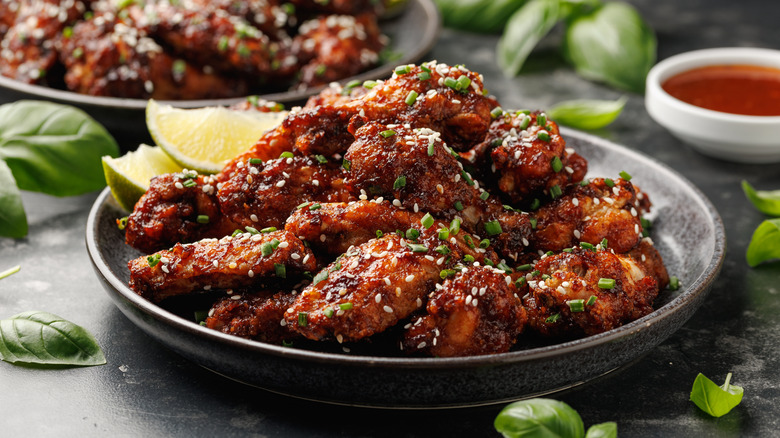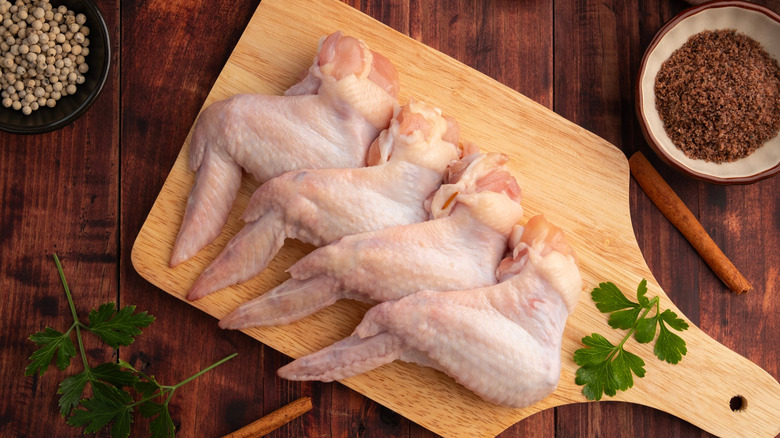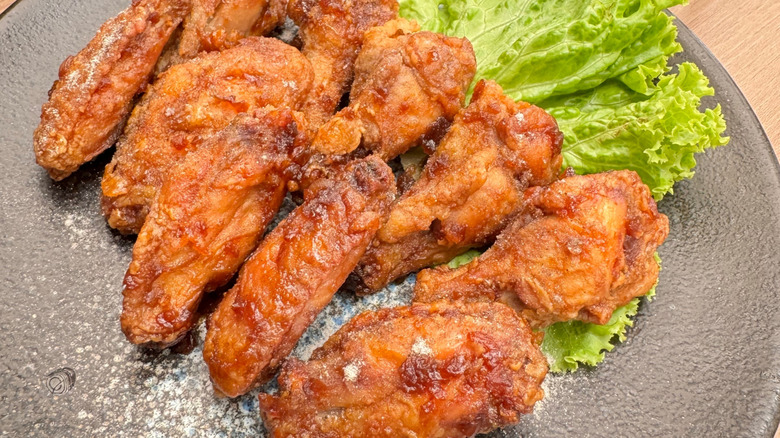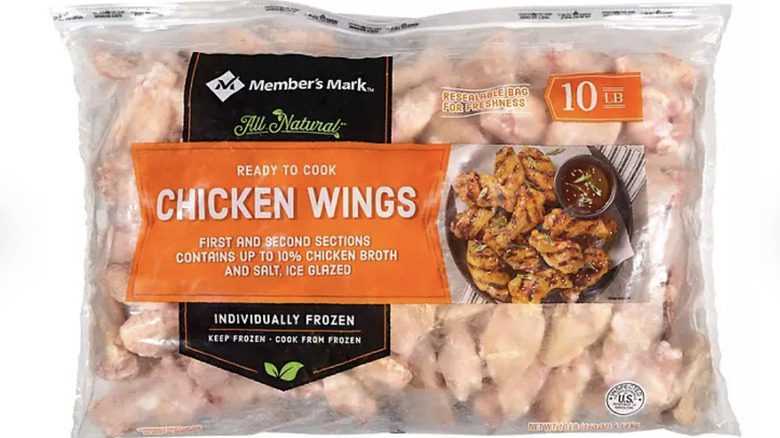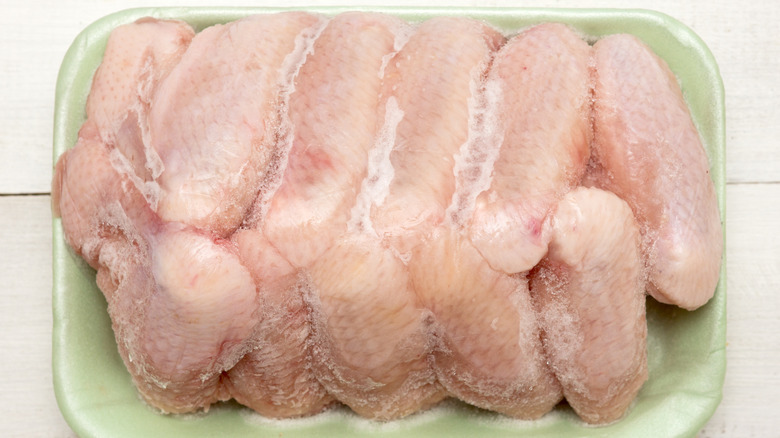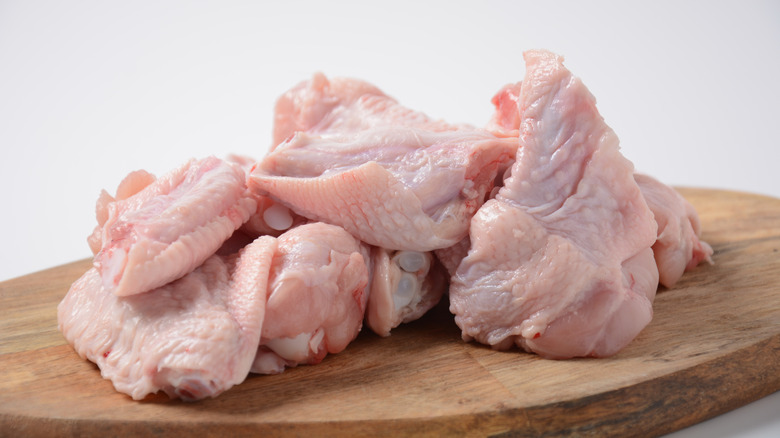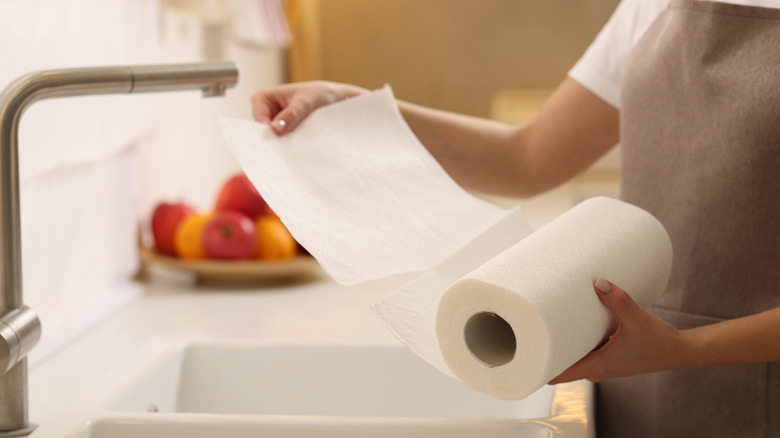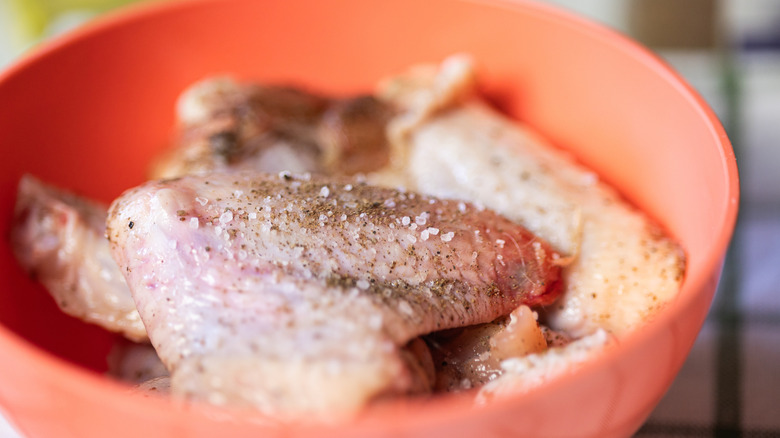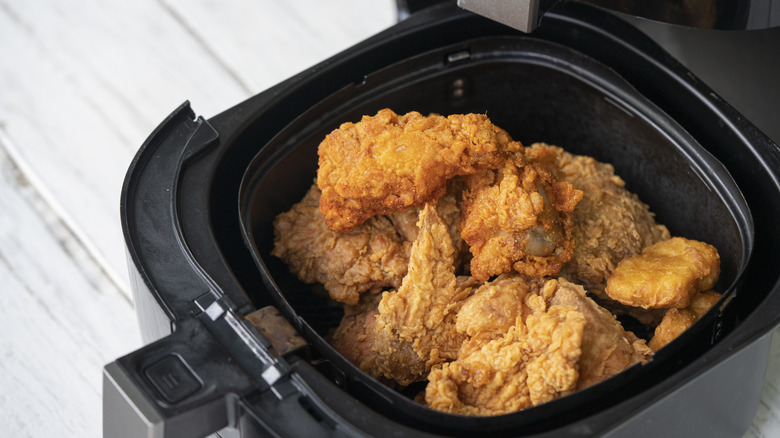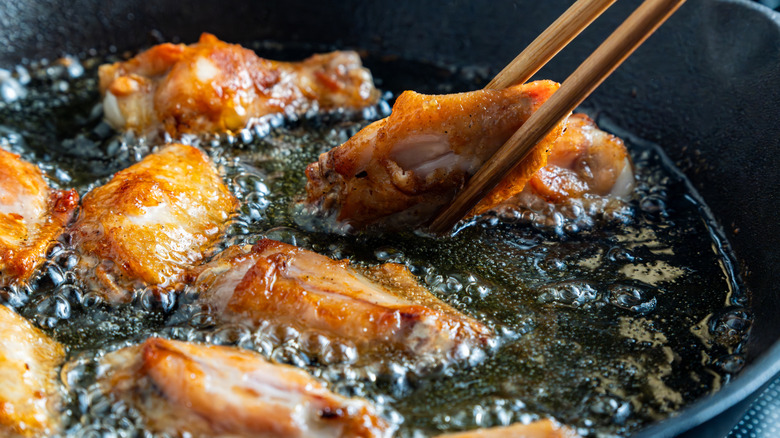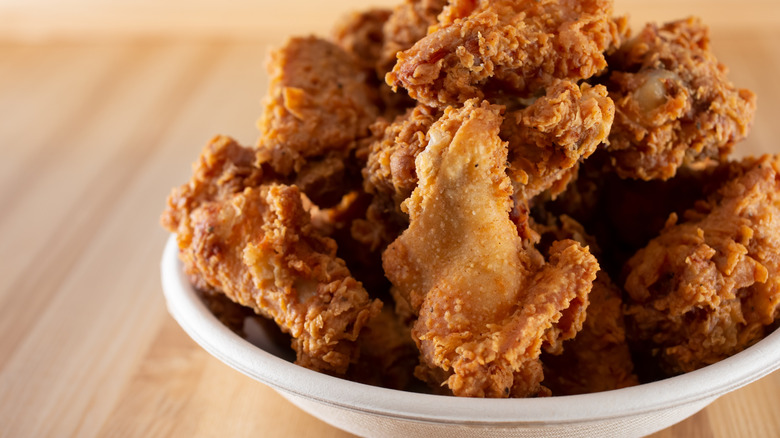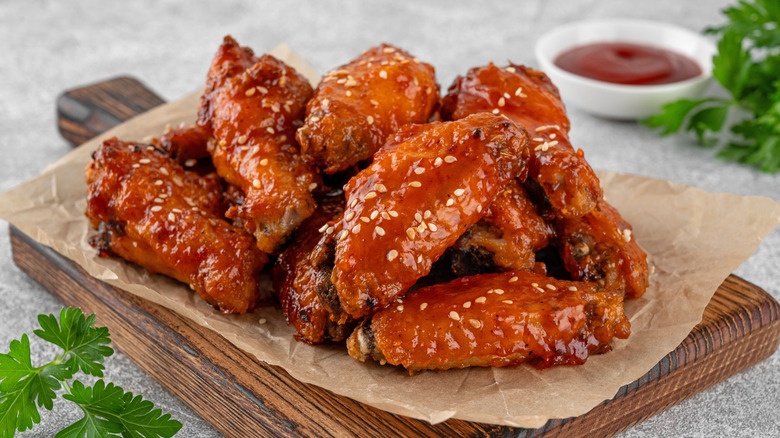13 Mistakes That Might Be Ruining Your Frozen Chicken Wings
We may receive a commission on purchases made from links.
America's appetite for chicken wings is undeniable. Recently, the National Chicken Council projected that Americans would indulge in 1.47 billion of these saucy bites during the 2025 Super Bowl. This astounding number isn't surprising, considering that chicken wings are a staple of the country's comfort food culture. No matter the occasion, the poultry pieces are bona fide crowd-pleasers.
Combining crispy skin and juicy, flavorful meat, chicken wings pair well with a wide range of sauces and seasonings. From classic recipes like Buffalo sauce wings to bolder options such as Korean gochujang, chicken wings are a canvas for culinary creativity. In addition, whether purchased seasoned or plain, chicken wings can be stored in the freezer for months without losing their flavor and texture. This makes these finger-lickin' bites a convenient meal option for today's busy lifestyles.
Frozen chicken wings can be a lifesaver in the kitchen, but there are a few dos and don'ts that can make the difference between mouthwatering success and a disappointing meal. Ready to learn more? Take a look at our list of some of the biggest mistakes that might be ruining your frozen chicken wings.
1. Choosing subpar raw chicken wings for home freezing
For some reason, it's easier to ignore the quality of poultry versus the quality of beef. Perhaps this is because chicken is often marinated, breaded, or added to other dishes, whereas we tend to associate beef with steak where imperfections are easy to spot. The reality is that the quality of chicken matters, even if you are planning to freeze it once you get home. Just like beef, poultry can vary in taste depending on its level of freshness, as well as how it has been processed and stored.
There are certain things to look out for when picking out fresh chicken wings for freezing. The poultry should be pinkish in color and relatively plump, so that when you press it with your finger, it springs back. A neutral aroma is also a good indicator of freshness. If possible, choose air-chilled chicken wings over water-chilled poultry, as they retain flavor and texture better without excess moisture. Liquid in the packaging is a sure sign that the poultry has been water-chilled, so avoid it. In addition, look for chicken wings that have never been frozen or stored below 26 degrees Fahrenheit, since freezing can change the texture. In other words, the last thing you want is to be freezing the chicken wings twice.
2. Failing to differentiate between wing types and ignoring labels
When buying chicken wings, it's important to distinguish between entire, uncut wings and wings that have been separated into drumettes, flats, and tips. For those not in the know, the drumette is the meatiest section of the wing, while the flat is made up of two parallel bones with meat in between. The tips of the wings contain little meat but can be used to make stock. If you buy entire chicken wings, it's best to cut them into drumettes, flats, and tips prior to freezing, as this simplifies the cooking later. While some people favor boneless chicken wings, these are not actually chicken wings. Instead, they are small pieces of chicken breast that are cut into chunks to resemble parts of the wings.
Much like selecting the wrong type of chicken wings, neglecting to read the labels on packaged chicken can compromise the quality of your meal. Don't miss this crucial step, as it can provide you with a surprising amount of information. Poultry that has been certified organic means that the chickens have been raised on organic feed. Labels stating "raised without antibiotics" mean that the poultry was never given antibiotics, whereas "antibiotic-free" indicates that antibiotics may have been used but have since cleared the bird's system. If you see "enhanced" on a chicken wing label, run for the hills. The term means that the poultry has been injected with solutions like saltwater or broth, which can alter its flavor and infuse them with nitrates, nitrites, and MSG.
3. Not picking the right pre-packaged frozen chicken wings
There is a good reason why supermarket freezers are a favorite stop for many shoppers. Frozen meals are convenient, offering pre-made options that don't require much preparation and clean-up. They are also affordable and can be stored in the freezer for many months. However, next time you reach for that bag of frozen chicken wings, it's important to keep in mind that not all frozen poultry is created equal.
Just like fresh chicken wings sold at your local butcher or grocery store, pre-packaged frozen chicken wings vary in flavor and texture. When buying frozen chicken wings, it's important to determine whether they have been pre-cooked. While they are likely to taste better once cooked, raw frozen chicken wings will normally take longer to prepare — they can also pose a safety hazard if not cooked properly, but more on that later. In addition, frozen chicken wings come in a range of flavors, so it's worth exploring different options to find the ones that you enjoy the most.
4. Not freezing your chicken wings appropriately
Believe it or not, there is a certain art to freezing chicken wings. Firstly — and most importantly — frozen poultry should be stored at temperatures below 0 degrees Fahrenheit. Once in the freezer, chicken wings can be kept indefinitely, although they will gradually lose freshness over time. For this reason, it's best to use them within 9 months of freezing.
Chicken wings can deteriorate in quality if not stored correctly in the freezer. One of the biggest issues is freezer burn, a result of air exposure that can create ice crystals and discoloration on the surface of the poultry. Fortunately, a little care when preparing chicken wings for freezing can go a long way toward preserving their texture and flavor. For best results, transfer the poultry from the store packaging to freezer-safe bags, squeezing out as much air as possible before freezing. Also, lay the wings flat to freeze them quickly and separate the pieces into meal-sized portions so you don't have to defrost more poultry than you need.
5. Ignoring food safety when defrosting frozen chicken wings
Uncooked poultry can harbor harmful bacteria, including salmonella, listeria, and E. coli. As such, mishandling raw poultry can leave you and your family with a nasty case of food poisoning. Luckily, following a few simple food safety measures when storing and thawing your chicken wings can help keep everyone safe.
There are a few ways to thaw frozen chicken wings, but some are safer than others. The best method to defrost poultry is to transfer it from the freezer to the refrigerator. Since refrigerators stay below 40 degrees Fahrenheit, the chicken wings can thaw slowly, never entering the "danger zone" between 40 and 140 degrees Fahrenheit where bacteria thrive. When defrosting chicken in the refrigerator, it's best to place it on the bottom shelf to prevent any juices from dripping and contaminating other food.
If you are strapped for time, you can also thaw frozen chicken wings under cool running water. That said, it's important not to use hot water to thaw the poultry as this can bring the exterior of the meat above 40 degrees Fahrenheit while the interior remains frozen. If you are in a pinch, you can also defrost chicken wings in the microwave, although this method isn't recommended. Not only can it affect the texture and flavor of the poultry, but the chicken must be cooked immediately after thawing to prevent bacterial growth.
6. Cooking chicken wings straight out of the freezer
Sometimes it's difficult to plan ahead, especially when juggling work, family, and other responsibilities. However, no matter how tempted you may be to cook frozen chicken wings straight out of the freezer without thawing, failing to defrost the poultry is likely to leave you with a subpar meal. This is because frozen chicken cooks unevenly, often leaving the outside of the poultry overdone while the inside remains raw and uncooked. It's important to remember that frozen chicken also takes around 50% longer to cook than fresh poultry.
While it isn't recommended, cooking chicken wings from frozen can be done if there is no time for defrosting. However, it's important to note that this shouldn't be done in a slow cooker, which heats too slowly to ensure that the poultry stays out of the temperature "danger zone," where bacteria can multiply quickly. Similarly, cooking frozen chicken wings in the microwave is likely to leave them overdone on the outside and undercooked in the center. For best results, cook frozen chicken wings in the oven at around 350 to 365 degrees Fahrenheit, a slightly lower temperature than you would use to prepare fresh wings. Alternatively, you can also cook chicken wings from frozen in an air fryer or an instant pot.
7. Forgetting to pat the chicken wings dry before cooking
To begin, you should never wash raw chicken wings under running water in an open sink, since this could spread harmful bacteria like salmonella around your kitchen. Instead, keep the poultry contained in a bowl, then dry it prior to cooking. Cooking wet chicken wings doesn't just increase the risk of dangerous oil splatters, but it can also make the bites soggy and prevent browning, leaving the skin rubbery instead of deliciously crispy.
To cut a long story short, moisture can interfere with the browning process. Perhaps one Reddit user explains this best, saying, "Maillard reaction (browning of the food) only happens above 140C [284 degrees Fahrenheit]. Water only goes up to 100C [212 degrees Fahrenheit] so if you don't dry off the surface of the food, it will have an unpleasant greyish steamed exterior rather than a crispy golden brown exterior."
To ensure that your chicken wings develop an appealing crust rather than soggy skin, be sure to pat them dry with a paper towel after they have defrosted. Alternatively, you can also air-dry the poultry in the refrigerator. To do this, simply place the wings on a plate and leave them uncovered for a few hours — this step could easily become a part of the thawing process.
8. Under-seasoning the chicken wings
Buying pre-packaged chicken wings that have been pre-seasoned and pre-sauced can have its advantages. Not only are there plenty of flavor options to select from in the supermarket freezer, but frozen chicken wings can also mean less time in the kitchen. That said, some chicken wing enthusiasts have complained that pre-made frozen chicken wings don't always live up to expectations. More specifically, some have said that they can be under-seasoned and under-sauced, which means that you will probably have to fix them up at home anyway.
Customizing plain chicken wings is a great alternative to buying their pre-seasoned frozen counterparts. For optimal results, defrost the wings before coating them in spices and seasonings. Alternatively, you can soak the chicken wings in a flavorful brine made with salt and aromatics like lemons, black peppercorns, garlic, scallions, and chili flakes — the options are only limited by your imagination. Just be sure to pat the wings dry before cooking, as any excess moisture will stop them from crisping up.
9. Never preparing chicken wings in an air fryer
Air fryers cook food by circulating hot air, offering a healthier alternative to many other popular cooking methods. For instance, while deep frying requires large amounts of oil, air frying can give chicken wings a crispy, golden exterior with just a light coating of oil. This significantly reduces the fat and calorie content in the poultry, making air frying a great option for those watching their weight. In addition, since air frying uses less oil, it minimizes splatters and makes kitchen cleanups much easier.
While we generally don't advise cooking chicken wings from frozen, in a last-minute dinner scramble, the air fryer is your best bet. To get things started, pop the frozen wings in the air fryer for approximately 10 minutes at 400 degrees Fahrenheit. Next, remove the wings from the basket and pour out any liquid that has collected at the bottom as the poultry thawed. Coat the chicken wings in oil, season, and return them to the air fryer. If you are using a sauce, don't forget to line the bottom of the air fryer basket with aluminum foil or parchment paper.
10. Cooking too many chicken wings at the same time
Just like cooking chicken wings straight from frozen is likely to make them soggy due to the moisture released during the thawing process, overcrowding the pan or air fryer is likely to have a similar effect. Instead of crisping up, the wings will end up steaming, resulting in skin that is soft and greasy.
The main problem with cooking too many chicken wings relates to residual moisture and insufficient heat. The more poultry you pack into the pan or cram inside an air fryer, the lower the surrounding temperature becomes. This, along with the moisture released by the meat, creates an environment that makes it impossible for the wings to become crispy.
If you are cooking for a large group of people, it's best to prepare the chicken wings in batches. Always arrange the poultry pieces in a single layer on a sheet pan, never stacking them on top of each other — the wings should not be touching. To keep the wings warm while you finish cooking the rest of the poultry, keep them in an oven preheated to 200 degrees Fahrenheit. To prevent any spills, line the baking sheet with aluminum foil.
11. Cooking the chicken wings for too long or not long enough
Most of us know that eating undercooked poultry can have disastrous consequences. Raw chicken carries harmful bacteria that can lead to some pretty nasty foodborne illnesses. This is why it's imperative that your chicken wings reach the internal temperature of at least 165 degrees Fahrenheit before serving. While chicken wings may look small, they can take surprisingly long to cook thoroughly — this is because bone-in meat usually takes longer to cook than boneless cuts. For instance, baking chicken wings in the oven can take up to an hour.
When in doubt as to whether the chicken wings have reached a safe internal temperature, use a meat thermometer. That said, there is a specific way to position the thermometer to get the most accurate readings. While this can be a little tricky, always try to stick the thermometer in the thickest part of the poultry. Additionally, make sure that the probe isn't touching the bone, as this can skew the readings.
While undercooking chicken wings can pose a health risk, overcooking them can strip away their juiciness and make them dry and tough. Overcooking can be particularly disappointing because chicken wings usually don't have much meat on them to begin with — the last thing you want is to ruin it. To avoid ending up with overdone chicken wings, bake them for around half an hour at 375 degrees Fahrenheit, then check whether they have cooked through using a meat thermometer.
12. Only cooking the chicken wings once
The contrast between the crispy, golden skin and the juicy meat of chicken wings can be hard to resist. Plus, the satisfying crunch of a well-fried wing adds a whole new dimension to each bite, elevating what might otherwise have been a simple meal to new heights. One of the best ways to achieve that big crunch is by double frying.
Often used to prepare Korean fried chicken, double frying involves initially frying the poultry at around 270 degrees Fahrenheit until the skin begins to crisp. The wings are then removed from the hot oil and allowed to cool before being returned for a second fry at a higher temperature of around 350 degrees Fahrenheit.
Although double frying takes a little extra time and effort, it's well worth it. Since chicken skin is mostly composed of fat and water, the resting period allows any excess moisture to evaporate, resulting in an ultra-crunchy exterior and a tender interior. Frying chicken wings on high heat for a longer period of time can also create a crispy outer layer, but it can overcook and dry out the poultry.
13. Failing to let the chicken wings rest after cooking
Like any other meat, poultry shouldn't be eaten right after it's been removed from the heat. Whether you are deep frying, baking, or air frying chicken wings, it's important to let them rest for a few minutes after cooking. Believe us when we say that a little patience can make all the difference to the flavor and texture of these bad boys.
When chicken wings cook, the juices migrate from the center to the surface. If you bite into the wings immediately after they have been cooked, you are likely to release these juices, leaving the center dry and unappetizing. Letting the chicken wings rest for a few minutes will ensure that the natural juices are reabsorbed into the meat, leaving it tender and moist.
In addition, poultry continues to cook once it's taken off the heat source in a process called carryover cooking time. Resting the chicken wings before digging in gives them a little extra time to finish cooking, helping them reach a safe internal temperature without overcooking the exterior.
